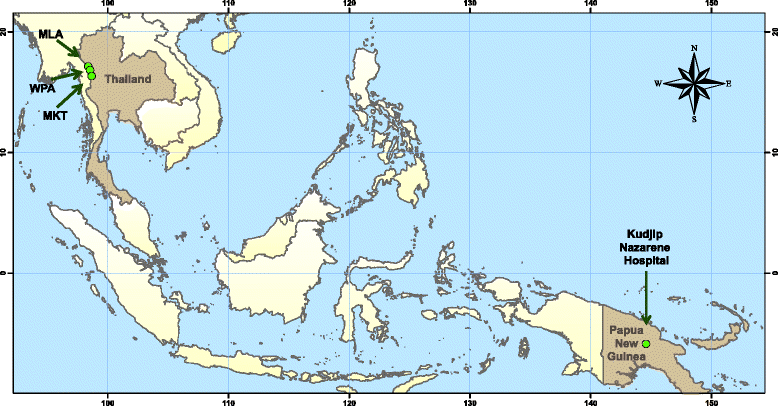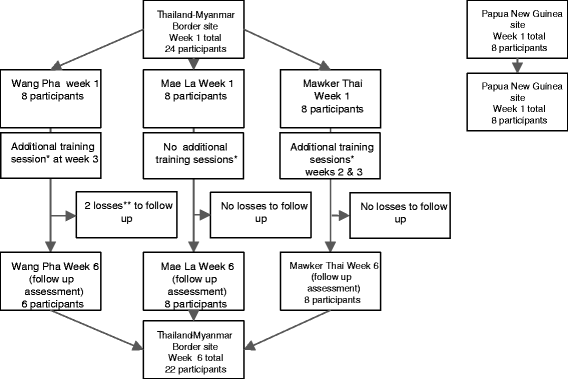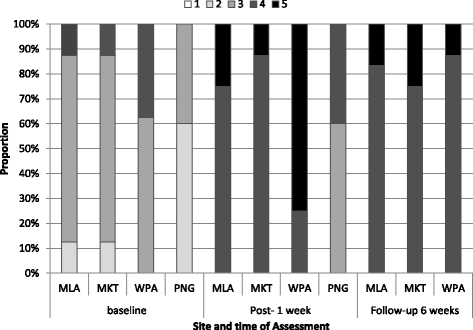Video-based feedback as a method for training rural healthcare workers to manage medical emergencies: a pilot study
- PMID: 28859651
- PMCID: PMC5580284
- DOI: 10.1186/s12909-017-0975-3
Video-based feedback as a method for training rural healthcare workers to manage medical emergencies: a pilot study
Abstract
Background: Video-based feedback has been shown to aid knowledge retention, skills learning and improve team functionality. We explored the use of video-based feedback and low fidelity simulation for training rural healthcare workers along the Thailand-Myanmar border and Papua New Guinea (PNG) to manage medical emergencies effectively.
Methods: Twenty-four study participants were recruited from three Shoklo Malaria Research Unit clinics along the Thailand-Myanmar border and eight participants from Kudjip Nazarene Hospital, PNG. The teams were recorded on video managing a simulated medical emergency scenario and the video was used to aid feedback and assess performance using Observed Structured Clinical Examination (OSCE) scoring and Team Emergency Assessment Measure (TEAM) questionnaire. The process was repeated post-feedback at both sites and at 6 weeks at the Thailand-Myanmar border site. Thailand-Myanmar border participants' individual confidence levels and baseline knowledge (using OSCE scoring) were assessed before team assessment and feedback at week 1 and repeated post-feedback and at 6 weeks. Focus group discussions (FGD) were held at each Thailand-Myanmar border clinic at week 1 (8 participants at each clinic).
Results: Individual paired tests of OSCE scores showed significant improvement post-feedback at week 1 (p < 0.001) and week 6 (p < 0.001) compared to baseline OSCE scores. There was a trend for increased team OSCE scores compared to baseline at week 1 (p = 0.068) and week 6 (p = 0.109) although not significant. Thailand-Myanmar border TEAM scores demonstrated improvement post-feedback mainly in leadership, teamwork and task management which was sustained up to week 6. PNG showed an improvement mainly in teamwork and task management. The global rating of the teams' non-technical performance at both sites improved post feedback and at week 6 on the Thailand-Myanmar border site. Self-rated confidence scores by Thailand-Myanmar border participants increased significantly from baseline following training at week 1 (p = 0.020), and while higher at 6 weeks follow up than at baseline, this was not significant (p = 0.471). The FGD revealed majority of participants felt that watching the video recording of their performance and the video-based feedback contributed most to their learning.
Conclusion: Video-assisted feedback resulted in an improvement in clinical knowledge, confidence and quality of teamwork for managing medical emergencies in two low resource medical facilities in South East Asia and the South Pacific.
Keywords: Confidence; Direct observation; Feedback; Self-assessment; Video.
Conflict of interest statement
Ethics approval and consent to participate
No formal ethical approval was sought for this pilot exploration of educational methods. As part of standard process the details of this project were presented, discussed and approved by the local Community Advisory Board (TCAB-311-12,016), Mae Sot Thailand. On both the Thailand-Myanmar border and in PNG, participants were verbally asked if they would like to participate in a training where they would be videoed and assessed. Consent was limited to those rostered for the shift on the day. The results of their assessments have been used anonymously.
Consent for publication
Not applicable.
Competing interests
The authors declare that they have no competing interests.
Publisher’s Note
Springer Nature remains neutral with regard to jurisdictional claims in published maps and institutional affiliations.
Figures
References
-
- World Health Organization. The World Health Report: 2006: working together for health. WHO press. 2006. http://www.who.int/whr/2006/whr06_en.pdf. Accessed 11 Sept 2016.
-
- Pagaiya N, Noree T. Thailand's health workforce: a review of challenges and the experiences (version 2). Bangkok. International Health Policy Program, Ministry of Health. 2009. http://siteresources.worldbank.org/HEALTHNUTRITIONANDPOPULATION/Resource.... Accessed 11 Sep 2016.
-
- UNFPA Myanmar. Report on situation analysis of population and development, reproductive health and gender in Myanmar. 2010. http://countryoffice.unfpa.org/myanmar/2010/08/03/2561/executive_summary/. Accessed 11 Jan 16.
-
- WHO and the National Department of Health, Papua New Guinea. Papua New Guinea health service delivery profile. 2012. http://www.wpro.who.int/health_services/service_delivery_profile_papua_n.... Accessed 04 Mar 16.
MeSH terms
LinkOut - more resources
Full Text Sources
Other Literature Sources
Medical




